Cadence
In Western musical theory, a cadence (Latin cadentia, "a falling") is "a melodic or harmonic configuration that creates a sense of resolution [finality or pause]."[1] A harmonic cadence is a progression of (at least) two chords that concludes a phrase, section, or piece of music.[2] A rhythmic cadence is a characteristic rhythmic pattern that indicates the end of a phrase.[3]
A cadence is labeled more or less "weak" or "strong" depending on its sense of finality. While cadences are usually classified by specific chord or melodic progressions, the use of such progressions does not necessarily constitute a cadence—there must be a sense of closure, as at the end of a phrase. Harmonic rhythm plays an important part in determining where a cadence occurs.
Cadences are strong indicators of the tonic or central pitch of a passage or piece.[1] Edward Lowinsky proposed that the cadence was the "cradle of tonality".[4]
Common classifications
In music of the common practice period, cadences are divided into four main types, according to their harmonic progression: authentic (typically perfect authentic or imperfect authentic), half, plagal, and deceptive. Typically, phrases end on authentic or half cadences, and the terms plagal and deceptive refer to motion that avoids or follows a phrase-ending cadence. Each cadence can be described using the Roman numeral system of naming chords.
Authentic cadence
An authentic cadence is a cadence from V to I (i.e. dominant to tonic). A seventh above the root is often added to create V7, and the V is often preceded by a cadential 6
4 chord. The Harvard Concise Dictionary of Music and Musicians says, "This cadence is a microcosm of the tonal system, and is the most direct means of establishing a pitch as tonic. It is virtually obligatory as the final structural cadence of a tonal work."[1] Authentic cadences are generally classified as either perfect or imperfect. The phrase perfect cadence is sometimes used as a synonym for authentic cadence but can also have a more precise meaning depending on the chord voicing.
Perfect authentic cadence
In a perfect authentic cadence (PAC), the chords are in root position – that is, the roots of both chords are in the bass – and the tonic is in the highest voice of the final chord. This is generally considered the strongest type of cadence and often found at structurally defining moments.[6] Music theorist William Caplin writes that the perfect authentic cadence "achieves complete harmonic and melodic closure."[7]
Imperfect authentic cadence
There are three distinct types of imperfect authentic cadences (IAC):[8]
- Root position IAC (shown below): Similar to a perfect authentic cadence, but the highest voice is not the tonic.
- Inverted IAC: Similar to a perfect authentic cadence, but one or both chords are inverted.
- Leading-tone IAC: The V chord is replaced with the viio chord (but the cadence still ends on I).
Evaded cadence
An evaded cadence goes from V4
2 to I6
.[9] Because the seventh must fall stepwise, it forces the cadence to resolve to the less stable first inversion chord. To achieve this, a root position V usually changes to a V4
2 right before resolution, thereby "evading" the cadence. (See also inverted cadence below.)
Half cadence
A half cadence (also called an imperfect cadence or semicadence) is any cadence ending on V, whether preceded by II (V of V), ii, vi, IV, or I—or any other chord. Because it sounds incomplete or suspended, the half cadence is considered a weak cadence that calls for continuation.[10]
Several types of half cadences are described below.
Phrygian half cadence
A Phrygian half cadence is a half cadence iv6–V in minor, so named because the semitonal motion in the bass (sixth degree to fifth degree) resembles the half-step heard in the ii–I of the 15th-century cadence in the Phrygian mode. Due to its being a survival from modal Renaissance harmony this cadence gives an archaic sound, especially when preceded by v (v–iv6–V).[12] A characteristic gesture in Baroque music, the Phrygian cadence often concluded a slow movement immediately followed by a faster one.[13] With the addition of motion in the upper part to the sixth degree, it becomes the Landini cadence.[1]
Lydian cadence
A Lydian cadence is similar to the Phrygian half cadence, involving iv6–V in the minor. The difference is that in the Lydian cadence, the whole iv6 is raised by a half step. In other words, the Phrygian half cadence begins with the first chord built on scale degree ![]()
![]()
Burgundian cadences
Burgundian cadences became popular in Burgundian music. Note the parallel fourths between the upper voices.[14]
Plagal half cadence
The rare plagal half cadence involves a IV–I progression. Like an authentic cadence (V–I), the plagal half cadence involves an ascending fifth (or, by inversion, a descending fourth).[15] The plagal half cadence is a weak cadence, ordinarily at the ending of an antecedent phrase, after which a consequent phrase commences. One example of this use is in "Auld Lang Syne". But in one very unusual occurrence – the end of the exposition of the first movement of Brahms' Clarinet Trio, Op. 114—it is used to complete not just a musical phrase but an entire section of a movement.[16]
Plagal cadence
A plagal cadence is a cadence from IV to I. It is also known as the Amen cadence because of its frequent setting to the text "Amen" in hymns.
William Caplin disputes the existence of plagal cadences in music of the classical era:
An examination of the classical repertory reveals that such a cadence rarely exists. ... Inasmuch as the progression IV–I cannot confirm a tonality (it lacks any leading-tone resolution), it cannot articulate formal closure .... Rather, this progression is normally part of a tonic prolongation serving a variety of formal functions – not, however a cadential one. Most examples of plagal cadences given in textbooks actually represent a postcadential codetta function: that is, the IV–I progression follows an authentic cadence but does not itself create genuine cadential closure.[17]
It may be noticed that the plagal cadence, "leaves open the possibility of interpretation as V–I–V" rather than I–IV–I.[10] The term "minor plagal cadence" is used to refer to the iv–I progression. Sometimes a combination of major and minor plagal cadence is used (IV–iv–I)
Deceptive cadence
“A cadence is called ‘interrupted’, ‘deceptive’ or ‘false’ where the penultimate, dominant chord is followed not by the expected tonic, but by another one, often the submediant.”[18]. This is the most important irregular resolution,[19] most commonly V7–vi (or V7–♭VI) in major or V7–VI in minor.[19][20] This is considered a weak cadence because of the "hanging" (suspended) feeling it invokes.
At the beginning of the final movement of Gustav Mahler's 9th Symphony, the listener hears a string of many deceptive cadences progressing from V to IV6.
One of the most striking uses of this cadence is in the A-minor section at the end of the exposition in the first movement of Brahms' Third Symphony. The music progresses to an implied E minor dominant (B7) with a rapid chromatic scale upwards but suddenly sidesteps to C major. The same device is used again in the recapitulation; this time the sidestep is—as one would expect—to F major, the tonic key of the whole Symphony.
The interrupted cadence is also frequently used in popular music. For example, the Pink Floyd song "Bring the Boys Back Home" ends with such a cadence (at approximately 0:45–50).
Other classifications
Inverted cadence
An inverted cadence (also called a medial cadence) inverts the last chord. It may be restricted only to the perfect and imperfect cadence, or only to the perfect cadence, or it may apply to cadences of all types.[21] To distinguish them from this form, the other, more common forms of cadences listed above are known as radical cadences.[22]
Rhythmic classifications
Cadences can also be classified by their rhythmic position:
- A metrically accented cadence occurs on a strong position, typically the downbeat of a measure.
- A metrically unaccented cadence occurs in a metrically weak position, for instance, after a long appoggiatura.
Metrically accented cadences are considered stronger and are generally of greater structural significance. In the past, the terms masculine and feminine were sometimes used to describe rhythmically "strong" or "weak" cadences, but this terminology is no longer acceptable to some.[23] Susan McClary has written extensively on the gendered terminology of music and music theory in her book Feminine Endings.[24]
The example below shows a metrically unaccented cadence (IV–V–I). The final chord is postponed to fall on a weak beat.[25]
Picardy third
A Picardy third (or Picardy cadence) is a harmonic device that originated in Western music in the Renaissance era. It refers to the use of a major chord of the tonic at the end of a musical section that is either modal or in a minor key. The example below shows a picardy third in J.S. Bach's Jesu, meine Freude (Jesus, My Joy), mm. 12–13.[26]
Upper leading-tone cadence
The example below shows a cadence featuring an upper leading-tone from a well-known 16th-century lamentation, the debate over which was documented in Rome c.1540.[27] The final three written notes in the upper voice are B–C–D, in which case a trill on C produces D. However, convention implied a C♯, and a cadential trill of a whole tone on the second to last note produces D♯/E♭, the upper leading-tone of D♮. Presumably, the debate was over whether to use C♯–D♯ or C♯–D for the trill. (![]()
![]()
In medieval and Renaissance polyphony
Medieval and Renaissance cadences are based upon dyads rather than chords. The first theoretical mention of cadences comes from Guido of Arezzo's description of the occursus in his Micrologus, where he uses the term to mean where the two lines of a two-part polyphonic phrase end in a unison.
Clausula vera
A clausula or clausula vera ("true close") is a dyadic or intervallic, rather than chordal or harmonic, cadence. In a clausula vera, two voices approach an octave or unison through stepwise motion[28] in contrary motion.
In three voices, the third voice often adds a falling fifth creating a cadence similar to the authentic cadence in tonal music.[28]
According to Carl Dahlhaus, "as late as the 13th century the half step was experienced as a problematic interval not easily understood, as the remainder between the perfect fourth and the ditone:[29]
In a melodic half step, listeners of the time perceived no tendency of the lower tone toward the upper, or the upper toward the lower. The second tone was not the 'goal' of the first. Instead, musicians avoided the half step in clausulas because, to their ears, it lacked clarity as an interval. Beginning in the 13th century, cadences begin to require motion in one voice by half step and the other a whole step in contrary motion.
Plagal cadence
A plagal cadence was found occasionally as an interior cadence, with the lower voice in two-part writing moving up a perfect fifth or down a perfect fourth.[30]
Pause
A pause in one voice may also be used as a weak interior cadence.[30] The example below, Lassus's Qui vult venire post me, mm. 3–5, shows a pause in the third measure.
Evaded cadence
In counterpoint, an evaded cadence is one where one of the voices in a suspension does not resolve as expected, and the voices together resolved to a consonance other than an octave or unison[31] (a perfect fifth, a sixth, or a third).
Corelli cadence
The Corelli cadence, or Corelli clash, named for its association with the violin music of the Corelli school, is a cadence characterized by a major and/or minor second clash between the tonic and the leading-tone or the tonic and supertonic. An example is shown below.[32]
English cadence
Another "clash cadence", the English cadence, is a contrapuntal pattern particular to the authentic or perfect cadence. It features the blue seventh against the dominant chord[33], which in the key of C would be B♭ and G–B♮–D. Popular with English composers of the High Renaissance and Restoration periods in the 16th and 17th centuries, the English cadence is described as archaic[34] or old-fashioned[35] sounding. It was first given its name in the 20th century.
The hallmark of this device is the dissonant augmented octave (compound augmented unison) produced by a false relation between the split seventh scale degree, as shown below in an excerpt from O sacrum convivium by Thomas Tallis. The courtesy accidental on the tenor's G♮ is editorial.
Landini cadence
A Landini cadence (also known as a Landini sixth, Landini sixth cadence, or under-third cadence[36]) is a cadence that was used extensively in the 14th and early 15th century. It is named after Francesco Landini, a composer who used them profusely. Similar to a clausula vera, it includes an escape tone in the upper voice, which briefly narrows the interval to a perfect fifth before the octave.
Common Practice Period
The classical and romantic periods of musical history provide many examples of the way the different cadences are used in context.
Authentic cadences and half cadences
Mozart’s Romanze from his Piano Concerto No. 20 follows a familiar pattern of a pair of phrases, one ending with a half (imperfect) cadence and the other with an authentic (perfect) cadence:
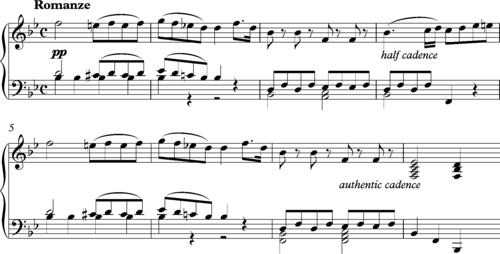
The presto movement from Beethoven’s String Quartet Op 130 follows the same pattern, but in a minor key:
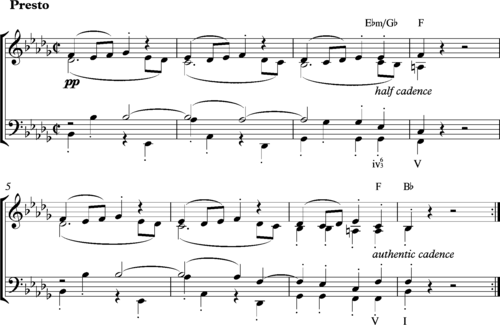
Plagal Cadences
The Hallelujah Chorus from Handel’s Messiah culminates powerfully with an iterated plagal cadence:

Debussy’s prelude ‘La Fille aux Cheveux de Lin’ opens with a plagal cadence:

One of the most famous endings in all music is found in the concluding bars of Wagner’s opera Tristan und Isolde, where the dissonant chord in the opening phrase of the opera is finally resolved "three enormous acts and five hours later" [37] in the form of a plagal cadence:

Deceptive Cadences
In Bach’s harmonization of the chorale ‘Wachet auf’, a phrase ending in a deceptive cadence repeats with the cadence changed to an authentic one:

The exposition of the first movement of Beethoven’s Piano Sonata No. 21 (The Waldstein Sonata), Op. 53 features a minor key passage where an authentic (perfect) cadence precedes a deceptive (interrupted) one:

Debussy’s Prelude “La fille aux cheveux de lin” (see also above) concludes with a passage featuring a deceptive (interrupted) cadence that progresses, not from V-VI, but from V-IV:

Some varieties of deceptive cadence that go beyond the usual V-VI pattern lead to some startling effects. For example, a particularly dramatic and abrupt deceptive cadence occurs in the second Presto movement of Beethoven’s Piano Sonata No. 30, Op. 109, bars 97-112, “a striking passage that used to pre-occupy [music] theorists.” [38] The music at this point is in B minor, and carries the expectation is that the Chord of F sharp (Chord V) will be followed by the tonic chord of B. However, “Dynamics become softer and softer; dominant and tonic chords of B minor appear isolated on the first beat of a bar, separated by silences: until in sudden fortissimo…the recapitulation bursts on us in the tonic E minor, the B minor dominants left unresolved.” [39]
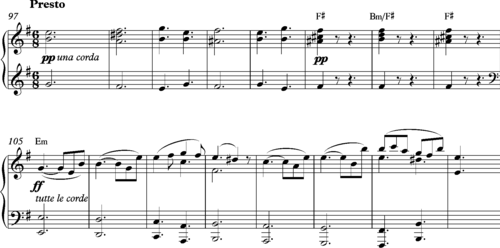
An equally startling example occurs in J.S. Bach’s Toccata and Fugue in F major, BWV 540:
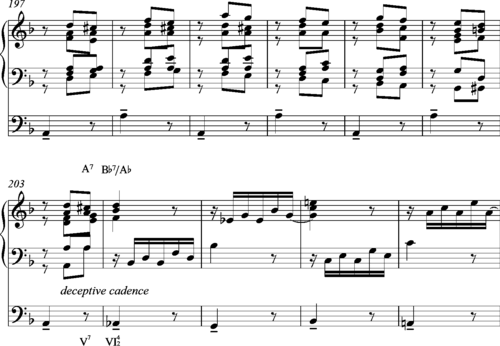
According to Richard Taruskin, in this Toccata, “the already much-delayed resolution is thwarted (m204) by what was the most spectacular ‘deceptive cadence’ anyone had composed as of the second decade of the eighteenth century… producing an especially pungent effect.” [40] Hermann Keller describes the effect of this cadence as follows: "the splendour of the end with the famous third inversion of the seventh chord, who would not be enthralled by that?"[41]
Chopin’s Fantaisie, Op. 49, composed over a century later in 1841, features a similar harmonic jolt:

A deceptive cadence is a useful means for extending a musical narrative. In the closing passage of Bach’s Prelude in F minor from Book II of the Well-Tempered Clavier, the opening theme returns and seems headed towards a possible final resolution on an authentic (perfect) cadence. What the listener may expect is:

Instead, at bar 60, Bach inserts a deceptive cadence (V-VI in F minor), leading to a lengthy digression of some dozen bars before reaching resolution on the final (V-I) cadence.
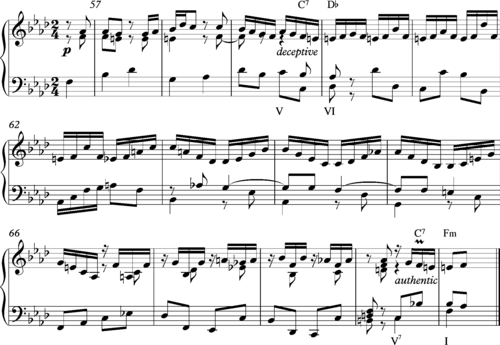
Classical cadential trill
In the Classical period, composers often drew out the authentic cadences at the ends of sections; the cadence's dominant chord might take up a measure or two, especially if it contained the resolution of a suspension remaining from the chord preceding the dominant. During these two measures, the solo instrument (in a concerto) often played a trill on the supertonic (the fifth of the dominant chord); although supertonic and subtonic trills had been common in the Baroque era, they usually lasted only a half measure.
Extended cadential trills were by far most frequent in Mozart's music, and although they were also found in early Romantic music, their use was restricted chiefly to piano concerti (and to a lesser extent, violin concerti) because they were most easily played and most effective on the piano and violin; the cadential trill and resolution would be generally followed by an orchestral coda. Beethoven was a good example of this, limiting it almost entirely to his concerti, and most other Romantic composers including Chopin and Schumann followed suit; Schubert, who did not write any concerti, hardly used it at all (the Adagio and Rondo Concertante D. 487, a chamber work, being one prominent exception). At the other end of the spectrum, even Mozart rarely used the trill in symphonies. Because the music generally became louder and more dramatic leading up to it, a cadence was used for climactic effect, and was often embellished by Romantic composers. Later on in the Romantic era, however, other dramatic virtuosic movements were often used to close sections instead.
Jazz
In jazz, a cadence is often referred to as a turnaround, chord progressions that lead back and resolve to the tonic (for example, the ii-V-I turnaround). Turnarounds may be used at any point and not solely before the tonic.
Half-step cadences are common in jazz if not cliché.[42] For example, the ascending diminished seventh chord half-step cadence, which—using a secondary diminished seventh chord—creates momentum between two chords a major second apart (with the diminished seventh in between).[43]
The descending diminished seventh chord half-step cadence is assisted by two common tones.[43]
Rhythmic cadence
Rhythmic cadences often feature a final note longer than the prevailing note values and this often follows a characteristic rhythmic pattern repeated at the end of the phrase.[3] The example below shows a characteristic rhythmic cadence at the end of the first phrase of J.S. Bach's Brandenburg Concerto No. 3 in G major, BMV 1048, mvmt. I, mm. 1–2:
See also
- Andalusian cadence
- Approach chord
- Cadential six-four
- Coda
- Cadenza
- Drum cadence
- Kadans
- Lament bass
- List of Caribbean music genres: cadence-lypso and cadence rampa
- V–IV–I turnaround
- ♭VII–V7 cadence
References
- Don Michael Randel (1999). The Harvard Concise Dictionary of Music and Musicians, p. 105-106. ISBN 0-674-00084-6.
- Benward & Saker (2003). Music: In Theory and Practice, Vol. I, p. 359. 7th ed. ISBN 978-0-07-294262-0.
- Benward & Saker (2003). p. 91.
- Judd, Cristle Collins (1998). "Introduction: Analyzing Early Music", Tonal Structures of Early Music, . (ed. Judd). New York: Garland Publishing. ISBN Cadence-is-the-best Parameter error in {{ISBN}}: Invalid ISBN..
- White, John D. (1976). The Analysis of Music, p.34. ISBN 0-13-033233-X.
- Thomas Benjamin, Johann Sebastian Bach (2003). The Craft of Tonal Counterpoint, p.284. ISBN 0-415-94391-4.
- Caplin, William E. (2000). Classical Form: A Theory of Formal Functions for the Instrumental Music of Haydn, Mozart, and Beethoven, p.51. ISBN 0-19-514399-X.
- Kostka, Stefan; Payne, Dorothy (2004). Tonal Harmony (5th ed.). Boston: McGraw-Hill. pp. 148–149. ISBN 0072852607. OCLC 51613969.
- Darcy and Hepokoski (2006). Elements of Sonata Theory: Norms, Types, and Deformations in the Late-Eighteenth-Century Sonata, p.. ISBN 0-19-514640-9. "the unexpected motion of a cadential dominant chord to a I6 (instead of the normatively cadential I)"
- Jonas, Oswald (1982). Introduction to the Theory of Heinrich Schenker (1934: Das Wesen des musikalischen Kunstwerks: Eine Einführung in Die Lehre Heinrich Schenkers), p. 24. Trans. John Rothgeb. ISBN 0-582-28227-6.
- White (1976), p.38.
- Finn Egeland Hansen (2006). Layers of musical meaning, p.208. ISBN 87-635-0424-3.
- Randel, Don Michael (2003). The Harvard Dictionary of Music, p. 130. ISBN 0-674-01163-5.
- White (1976), p.129-130.
- Harrison, Daniel (1994). Harmonic Function in Chromatic Music: A Renewed Dualist Theory and an Account of Its Precedents. University of Chicago Press. p. 29. ISBN 0226318087.
- Notley, Margaret (2005). "Plagal Harmony as Other: Asymmetrical Dualism and Instrumental Music by Brahms". The Journal of Musicology. 22 (1): 114–130. doi:10.1525/jm.2005.22.1.90.
- Caplin, William E. (1998). Classical Form: A Theory of Formal Functions for the Instrumental Music of Haydn, Mozart and Beethoven. Oxford University Press. pp. 43–45. ISBN 0-19-510480-3.
- Latham, A. (ed) (2002, p193) The Oxford Companion to Music. Oxford University Press.
- Foote, Arthur (2007). Modern Harmony in its Theory and Practice, p. 93. ISBN 1-4067-3814-X.
- Owen, Harold (2000). Music Theory Resource Book, p.132. ISBN 0-19-511539-2.
- Kennedy, Michael, ed. (2004). The Concise Oxford Dictionary of Music, p.116. ISBN 0-19-860884-5.
- "Medial cadence". Grove Music Online. Oxford Music Online. Oxford University Press. Web. 23 Jul. 2013.
- Society for Music Theory (1996-06-06). "Guidelines for Nonsexist Language". Western Michigan University. Retrieved 2008-07-19.
- McClary, Susan (2002). Feminism and Music. University of Minnesota Press. ISBN 0-8166-4189-7.
- Apel, Willi (1970). Harvard Dictionary of Music. cited in McClary, Susan (2002). Feminine Endings: Music, Gender, and Sexuality, p.9. ISBN 0-8166-4189-7.
- Bruce Benward and Marilyn Nadine Saker, Music in Theory and Practice: Volume II, eighth edition (Boston: McGraw-Hill, 2009), p. 74. ISBN 978-0-07-310188-0.
- Berger, Karol (1987). Musica Ficta: Theories of Accidental Inflections in Vocal Polyphony from Marchetto da Padova to Gioseffo Zarlino, p. 148. Cambridge and New York: Cambridge University Press. ISBN 0-521-54338-X.
- Benward & Saker (2009). Music in Theory and Practice: Volume II, p. 13. Eighth Edition. ISBN 978-0-07-310188-0.
- Dahlhaus, Carl (1990). Studies in the Origin of Harmonic Tonality. trans. Robert O. Gjerdingen. Princeton University Press. ISBN 0-691-09135-8.
- Benward & Saker (2009), p. 14.
- Schubert, Peter (1999). Modal Counterpoint, Renaissance Style, p.132. ISBN 0-19-510912-0.
- Latham, Alison, ed. (2002). The Oxford Companion to Music, p.192. ISBN 0-19-866212-2.
- van der Merwe, Peter (2005). Roots of the Classical: The Popular Origins of Western Music, p.492. ISBN 0-19-816647-8.
- Carver, Anthony (1988). The Development of Sacred Polychoral Music to the Time of Schütz, p.136. ISBN 0-521-30398-2. If the clash cadence is already "archaic, [and/or] mannered" in the music of Heinrich Schütz (1585-1672) it must surely be so now.
- Herissone, Rebecca (2001). Music Theory in Seventeenth-Century England, p.170. ISBN 0-19-816700-8.
- van der Merwe, Peter (2005). Roots of the Classical: The Popular Origins of Western Music, p.501. ISBN 0-19-816647-8.
- Small, C. (1977, p.15), Music-Society-Education. London, John Calder.
- Rosen, C. (2002, p.232) Beethoven’s Piano Sonatas: a Short Companion. Yale University Press.
- Mellers, W. (1983, p.210), Beethoven and the Voice of God. London, Faber.
- Taruskin, R. (2005, p. 213), The Oxford History of Western Music, Vol. 2, Music of the Seventeenth and Eighteenth Centuries. Oxford University Press.
- Hauk, Franz and Iris Winkler (translated by Regina Piskorsch-Feick), 2001, from liner notes p.4 for recording by Franz Hauk, Johann Sebastian Bach Organ masterworks, Guild Music Ltd GMCD 7217
- Norman Carey (Spring, 2002). Untitled review: Harmonic Experience by W. A. Mathieu, p.125. Music Theory Spectrum, Vol. 24, No. 1, pp. 121–34.
- Richard Lawn, Jeffrey L. Hellmer (1996). Jazz: Theory and Practice, p.97-98. ISBN 978-0-88284-722-1.

